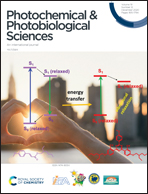Photodynamic activity attained through the ruptured π-conjugation of pyridyl groups with a porphyrin macrocycle: synthesis and the photophysical and photobiological evaluation of 5-mono-(4-nitrophenyl)-10,15,20-tris-[4-(phenoxymethyl)pyridine]-porphyrin and its Zn(ii) complex †
Abstract
This article compares a reported hydrophobic and photobiologically inert porphyrin synthon, (NPh)TPyP, bearing a single meso-4-nitrophenyl group and three meso-pyridyl groups (A3B type) with a new photobiologically active metal-free porphyrin, P3N, and its zinc-complex, P3NZn, which bear a meso-4-nitrophenyl group along with three distal pyridyl groups. Both P3N and P3NZn experience ruptured π-conjugation with the porphyrin macrocycle and attain hydrophilicity, as indicated via density functional theory (DFT) calculations, becoming photobiologically active under in vitro conditions. The non-invasive photodynamic activity (PDA) predominantly shown by the zinc-complex P3NZn (with higher hydrophilicity) towards KRAS-mutated human lung-cancer cells (A549) was studied. The results indicate the existence of intracellular singlet oxygen inflicted anticancer PDA, which is apparent through the upregulation of intracellular reactive oxygen species (ROS) and the downregulation of both intracellular superoxide dismutase (SOD) and intracellular reduced glutathione (GSH) levels. The trends obtained from both SOD and GSH assays were indicators of therapeutic defence against oxidative stress via neutralizing superoxide anions (SOA).
![Graphical abstract: Photodynamic activity attained through the ruptured π-conjugation of pyridyl groups with a porphyrin macrocycle: synthesis and the photophysical and photobiological evaluation of 5-mono-(4-nitrophenyl)-10,15,20-tris-[4-(phenoxymethyl)pyridine]-porphyrin and its Zn(ii) complex](/en/Image/Get?imageInfo.ImageType=GA&imageInfo.ImageIdentifier.ManuscriptID=D0PP00319K&imageInfo.ImageIdentifier.Year=2020)


 Please wait while we load your content...
Please wait while we load your content...